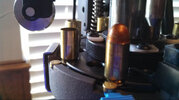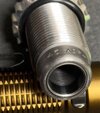CQB45ACP
Member
As for an undersized die increasing neck tension vs “simply” preventing set back I’d love to see an advocate do some testing and prove it. (Or a non-advocate perform an objective test.)
@JHTexas has a good explanation for why (in 9mm anyway) one could get the latter without actually getting the former. I hope I characterized that correctly and I don’t pretend (nor presume) to speak for him.
Try as I might, using an inertia hammer, I cannot tell the difference in friction/resistance from standard and undersized 9mm dies. This includes taper crimping and not taper crimping, expanding and not expanding—with slick, plated 115gr bullets, one whack is all it takes each time, every time.
I want to prove it’s true (that it increases neck tension) but haven’t been able to given my level of expertise. So I’m left with comparisons. (Yes, I disclose my limitations and biases.)
If it wasn’t such a PIA test, I’d have done this in 45acp by now too, but I have to go outside where I won’t bother anyone and potentially trash bullets and I don’t like that. Besides all my 45acp cases have already been undersized I think
I do know for 45acp, two whacks maybe three is my norm for breaking down 230gr RN .452”
And that includes undersized & standard, all expanded I think, and some taper crimped but most not. But I can’t tell you if all the “threes” were crimped and undersized thin walled cases. But these were done a few here and few there for the sole purpose of breaking them down and using for something else, not testing. Even a lame test.
@JHTexas has a good explanation for why (in 9mm anyway) one could get the latter without actually getting the former. I hope I characterized that correctly and I don’t pretend (nor presume) to speak for him.
Try as I might, using an inertia hammer, I cannot tell the difference in friction/resistance from standard and undersized 9mm dies. This includes taper crimping and not taper crimping, expanding and not expanding—with slick, plated 115gr bullets, one whack is all it takes each time, every time.
I want to prove it’s true (that it increases neck tension) but haven’t been able to given my level of expertise. So I’m left with comparisons. (Yes, I disclose my limitations and biases.)
If it wasn’t such a PIA test, I’d have done this in 45acp by now too, but I have to go outside where I won’t bother anyone and potentially trash bullets and I don’t like that. Besides all my 45acp cases have already been undersized I think
I do know for 45acp, two whacks maybe three is my norm for breaking down 230gr RN .452”
And that includes undersized & standard, all expanded I think, and some taper crimped but most not. But I can’t tell you if all the “threes” were crimped and undersized thin walled cases. But these were done a few here and few there for the sole purpose of breaking them down and using for something else, not testing. Even a lame test.
Last edited:





